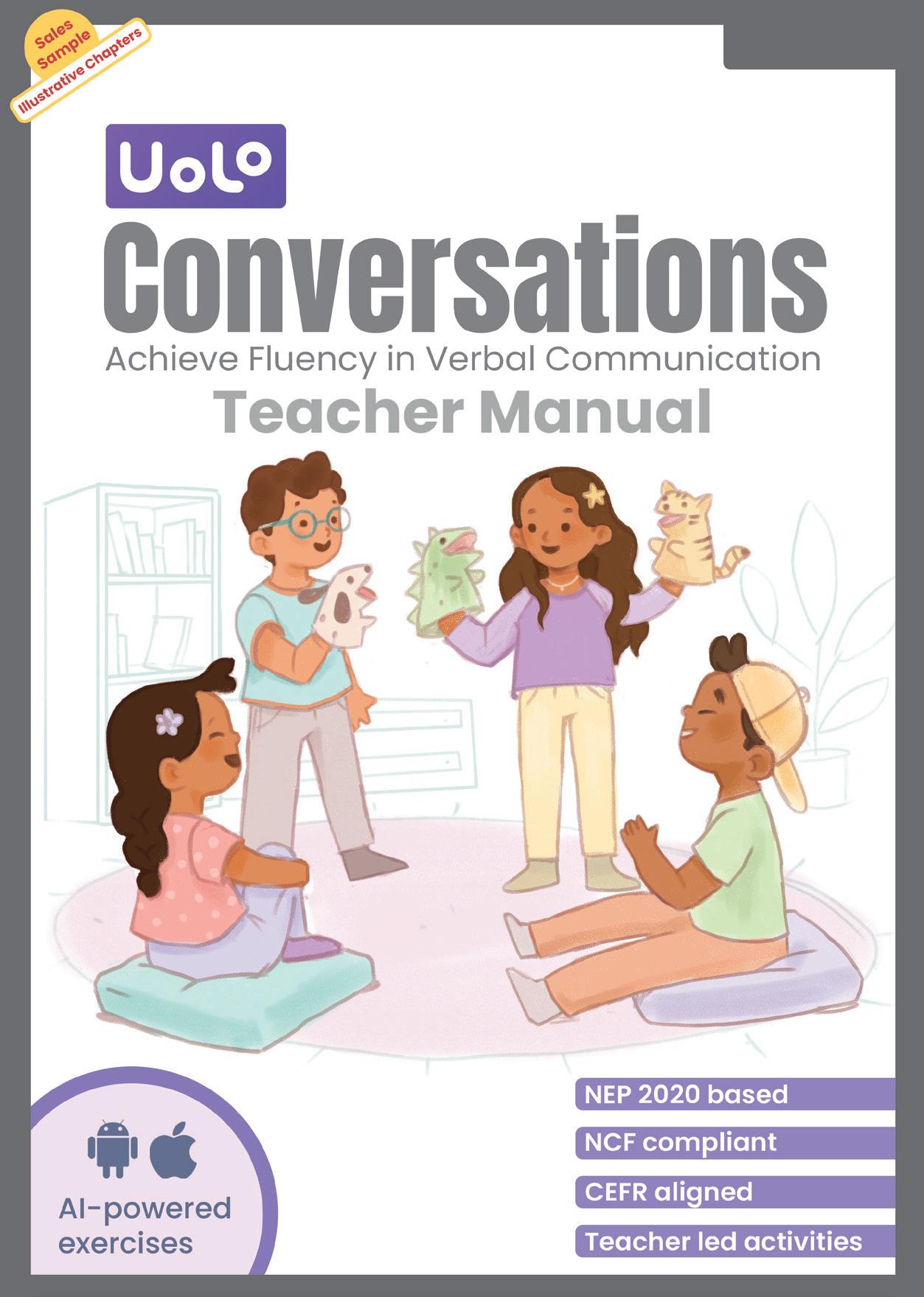
Grade 5

Achieve Fluency in Verbal Communication Grade 5 Teacher Manual
Conversations
Thanks to globalization and the emergence of technologies, international boundaries have become blurred. English, to a high degree, is a commonly understood medium of communication. It is one of the key tools that students need to perform well today and in the future. According to a global study, while recruiting, 98.5% of employers implicitly or explicitly assess a candidate’s English communication skills! There is therefore a growing demand for English communication skills, because it empowers people and enables them to lead a better life.
Functional communication skills, involving aspects of LSRW (listening, speaking, reading and writing), are central to knowledge acquisition, children’s intellectual, social and emotional growth, and life-long learning.
Specifically, strong listening and speaking skills are not only vital in the overall language learning process, but also lead to better reading and writing skills. Yet, these foundational skills tend to be neglected in schools due to the high pupil-teacher ratio, lack of oral language-focused assessment, and most importantly, a lack of systematic and allocated practice time for these skills within the classroom.
Aligned with NEP 2020, NCERT learning outcomes and standardized to CEFR (Common European Framework for Reference) levels, Uolo Speak is a hybrid learning program that focuses on building, applying, practising, and assessing these core language skills.

First, through this book as one of the components of the program, the English classroom becomes an avenue to hone functional speaking skills in real time. The teacher-led activities give learners the opportunity to undertake high-quality, level-appropriate, and experiential activities that help to build confidence and expression in English.
Second, the mobile interface of the product ensures consistent practice of functional LSRW skills. These exercises go beyond traditional question types and employ cutting-edge technology to enable learning and generate instant feedback. For instance, learners practise speaking with Al (artificial intelligence), as if conversing with a real person!
Third, Uolo Speak assessment can be conducted by the school in sync with their academic calendars. The assessment is evaluated by Uolo’s English specialists to give performance report and feedback.
Foreword
ii
Finally, the reporting methodology used in the above three program components, generates a skill growth chart against CEFR levels for each learner, class and the school. Educators can then clearly identify learners who are reaching, meeting, and exceeding the level requirements, and support them accordingly.
Uolo Speak is a powerful, exciting, and unique experience for learners and teachers. It represents a real life and results-oriented approach to develop essential 21st century functional English skills.
Wishing all teachers, parents, and learners lots of fun and joyful experiences as you embark upon this exciting journey with Uolo Speak.
Dr Laraine O'Connell

D. Litt., English, North West University, South Africa
I am a veteran English teacher and lecturer, with a great love for English and for teaching. I have taught English and trained teachers over many years. I live in South Africa and it is a wonderful experience working with a company promoting the learning of English in India.
Foreword iii
Walkthrough
Each chapter is divided into three sections - Part A, E-Speak, Part B.

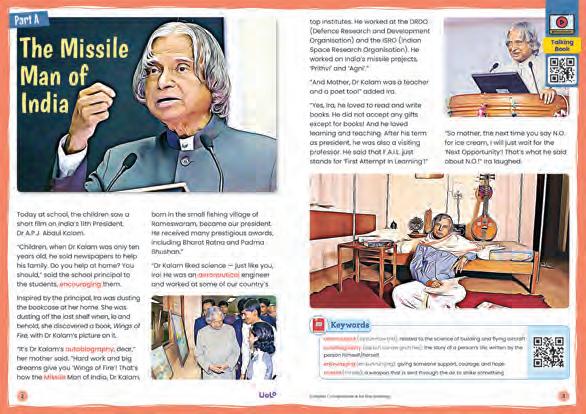
Part A should be completed in period 1, which includes reading aloud of a text and one listening-speaking activity to practise the competency targeted in the chapter.
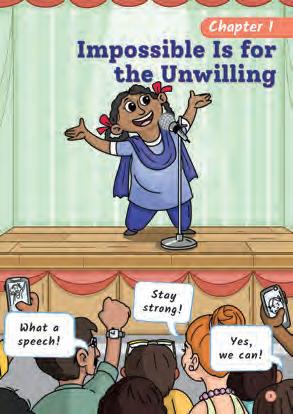



E-Speak comprises two digital activities aligned with target competency, which can be accessed through the given QR codes. These activities can be done at home or in school.

Part B focuses on learners’ presentations, which is prescribed to happen in period 2 after adequate practice of the chapter competency. It begins with a small warm up activity.
Tells the chapter number and chapter title, along with an image to convey the main idea of the chapter
A text to be read aloud and discussed in period 1
Scan the QR code to watch the animation of the text on mobile app
Scan the QR code to listen to the pronunciation of difficult words from text
iv
One listening speaking activity for practice in period 1
Prompts for learners to help them think before speaking





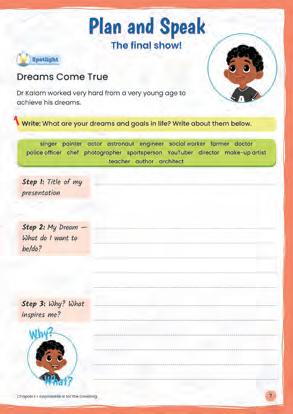
To get learners warmed up at the beginning of period 2
Digital section of the book, which features QR codes for two mobile app activities
Solo/pair/group presentations by learners, tied to the theme and competency of the chapter, in period 2
Graphic organisers for learners to plan for the presentation and write notes before speaking
Types of Activities
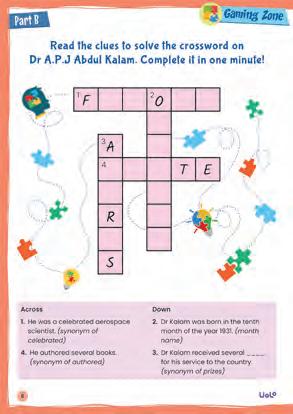
Learners work individually
Learners work in pairs
Learners work in groups of three/four/five
Teacher does the activity along with the whole class Quick tips for learners to help them make their presentations interesting
Space for learners to reflect on peers’ presentations and write their thoughts

v Walkthrough

Contents Chapter Outcomes vii Random Student Selection Activities ix Student Tracking Sheet x 1 Impossible Is for the Unwilling 2 The Missile Man of India 2 Ask and Answer 6 The Little Shepherd Boy 3 Can You Convince? 10 The Latest in Smartphones vi
Chapter Outcomes
Chapter No. Chapter Name Big Skill
1 Impossible is for the Unwilling
Giving short motivational speeches
2 Ask and Answer Asking questions and responding to them
3 Can You Convince?
Persuasive speaking
Listening Speaking Competencies
Appreciate key ideas in a motivational text Give short motivational speeches
Ask questions starting with what, where, why, when and how Respond to questions
Listen to and interpret key details in informational texts
Speak persuasively about advantages or disadvantages of something
vii
Random Student Selection Activities
In order to ensure the participation of the maximum number of learners during the classroom presentations and to keep the surprise element going, you can try the following quick games for inviting learners to participate:
• Pick the name chits from a bowl.
• Call out the roll number in a random fashion.
• Say some unique identification markers, e.g. the one who is carrying a blue water bottle, the one whose name starts with A, the one whose name ends with P, the one who has a red bag.
• Throw a ball and give an opportunity to the one who catches it.
• Sing a song/recite a poem while students swiftly pass an object on to each other. The one who is holding it when the song/poem ends, has to present.
• After their presentation, each student invites the next presenter.
• Open a book randomly at a page. Call out that (roll) number for presentation.
ix
Chapter 1 Chapter 2 Chapter 3
Student Number/Name

Plan and Speak
Speak on the Spot
Plan and Speak
Speak on the Spot x
Plan and Speak
Student
Tracking Sheet
Speak on the Spot
Chapter 4 Chapter 5 Chapter 6 Chapter 7 Chapter 8 Chapter 9
Plan and Speak
Speak on the Spot
Plan and Speak
Speak on the Spot
Plan and Speak
Speak on the Spot
Plan and Speak
Speak on the Spot
Plan and Speak
Speak on the Spot 1 Student Tracking Sheet
Plan and Speak
Speak on the Spot
Impossible Is for the Unwilling
About the Chapter: Through this chapter, learners will develop the skill of giving short motivational speeches.
Listening Speaking Competencies: Learners will be able to
• Appreciate key ideas in a motivational text.
• Give short motivational speeches.
Part A - Period 1
The Missile Man of India
• Read the story aloud OR play the Talking Book in the classroom.
10 min
• Ask questions as follows. Invite responses from the maximum number of learners. Before story: Can anyone guess why Dr Kalam is known as the Missile Man of India?
During Story: After “And Mother, Dr Kalam was a teacher and a poet too!” added Ira.: What are some of the qualities of Dr Kalam that inspire you?
After story: Dr Kalam always believed in the power of dreaming big and working hard to achieve those dreams. What do you dream of being or doing when you grow up?
Speak on the Spot!

Dr Kalam Fan Club
• Instruct: Look at the pictures of Dr Kalam.
20 min
• Discuss the qualities of Dr Kalam with learners, like his interest in books, his love for children, his passion for science etc. Recall his qualities from the text too.
• Instruct: Based on Dr Kalam’s nature, personality and qualities, think of a title for him. For example, ‘A True Hero’ (because he made India proud). Look at the example given too.
• Allot 1-2 minutes to think.
• Say: Now, I will call some of you to share the titles you have chosen. You also have to share the reason for choosing that title..
• Invite AS MANY learners as possible to present. Select randomly through games. (pagevii)

• Sample: Hi! I would give him the title, ‘The People’s Person’ because he liked to be around people and children, as seen in the pictures.

2
1
Chapter
Appreciate all presentations. Give concrete feedback.
Great work! The title you chose suits Dr Kalam well. He truly was a people’s person.
Homework 1: E-Speak
Instruct the learners to complete both projects in the E-Speak section.
Project 1: COVID Warrior
This project will be evaluated automatically. Scan the QR code to see your learners’ submissions.
Project 2: Send Us Your Taglines

This project will be evaluated by you. Scan the QR code to see your learners’ submissions.
Homework 2: Preparation for Part B
Explain part 1 and 2 in the Plan and Speak section for prep work. Facilitate as follows:
1. Instruct learners to think of the goal/dream/profession they would like to achieve as they grow up, and write about it in the given format. Guide them to use the prompts for ideas, if needed.
2. Suggest they practise their speech with a lot of expression and emotion.
3 Chapter 1 • Impossible Is for the Unwilling
•
5 min
• Instruct learners to complete the crossword using the clues of Across and Down.

• Set the time to one minute to make it a fun competition! You may use a stopwatch.
Plan and Speak
Dreams Come True
• Warm Up 5 min
A. Recapitulate the activity for the learners.


B. Instruct: Revise your notes. Practise how you want to present them.
• Presentation
and Feedback
30 min

• Invite ALL the learners, if possible, for the presentation. Select randomly through games. (page vii)
• Sample:

Dream of Travelling Around the World
I want to be a traveller! I want to travel across the world.
I want to travel because travelling is not only fun, but also very educative.
I would get to meet a variety of people, and know about their lives and cultures.
4 Part B - Period 2
I have already started working towards my goal. I read a lot of travel journals and take short trips with my parents. I also exercise daily so that I remain fit. I will work on my general knowledge and understanding of history and geography to be more informed about different places. I would also do a course on photography.
• Appreciate all presentations. Give concrete feedback on content, fluency and presentation.
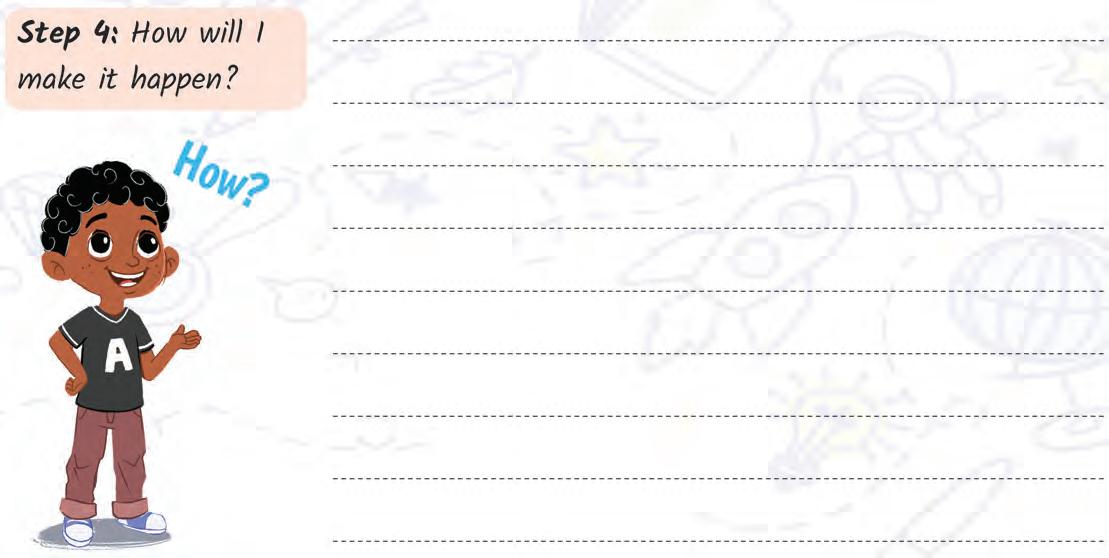
Thank you. I am really impressed with the wonderful aspirations you have – to travel the world! It is so refreshing and inspiring. Your plan of action to achieve your goal is also on point. I loved how you delivered your speech with such great enthusiasm.

5 Chapter 1 • Impossible Is for the Unwilling
About the Chapter: Through this chapter, learners will develop the skill of asking questions and responding to them.
Listening Speaking Competencies: Students will be able to:
• Ask questions starting with what, where, why, when and how.
• Respond to questions.
Part A - Period 1
The Little Shepherd Boy
• Read the story aloud OR play the Talking Book in the classroom.
10 min
• Ask questions as follows. Invite responses from as many learners as possible.
Before story: Read the title. Ask: Do you know what a shepherd is?

During Story: After “How many drops of water are there in the sea?”: What do you think is the answer? Can we count the drops of water in the sea? Why?
After “How many stars are there in the sky?”: Can we count the total number of stars in the sky? What do you think the boy must have answered?
After story: Do you think the little shepherd boy was clever? Why?
Speak on the Spot! 20 min
Bingo!
• Invite a volunteer and demonstrate the activity.
• Instruct:
A. Think of any one thing that is in your bag. I’m going to ask you some questions to find out what it is.
B. Ask: What is its shape? What it is made of? How it is used?
C. Say ‘Bingo’ aloud when you can identify the object.

• Do the activity once or twice until all learners understand.
• Explain: Similarly, I will think of an item. Now, you need to ask me questions to find out what it could be. You can ask what it looks like, what it is made of, what it is used for and so on. You need to say ‘Bingo!’ aloud as soon as you identify the object.

• Instruct: Keep count of how many objects you identified correctly. Keep writing in the book.
• Conduct this activity for at least 10-15 commonly found items. For example: chalk, water bottle, cap, soap, pencil, fan, shoes, etc.
Chapter 2
6
Ask and Answer
Homework 1: E-Speak
Instruct the learners to complete both projects in the E-Speak section.
Project 3: Can you help?

This project will be evaluated automatically. Scan the QR code to see the submissions of your learners.
Project 4: Long Time no See!
This project will be evaluated by you. Scan the QR code to see the submissions of your learners.
Homework 2: Preparation for Part B
Explain steps 1-3 in the Plan and Speak section for prep-work. Facilitate as follows.
1. Divide the class into groups of four.
2. Instruct groups to discuss and complete the interview script. Brief them on what an interview is. Guide them to use the prompts for ideas if needed.
3. Finally, suggest to groups that they divide the 4 roles among themselves and practise enacting the interview accordingly.
7 Chapter 2 • Ask and Answer
5 min
• Instruct learners to spot the greatest number of differences between the pictures.
• Allocate 1 minute to give it a fun-game twist.



• Instruct them to tick the ranks below for the number of differences they found.
Plan and Speak
Blockbuster Interview
• Warm Up 5 min
A. Recapitulate the activity for the learners.
B. Instruct: Revise the interview script. Practise saying your parts.
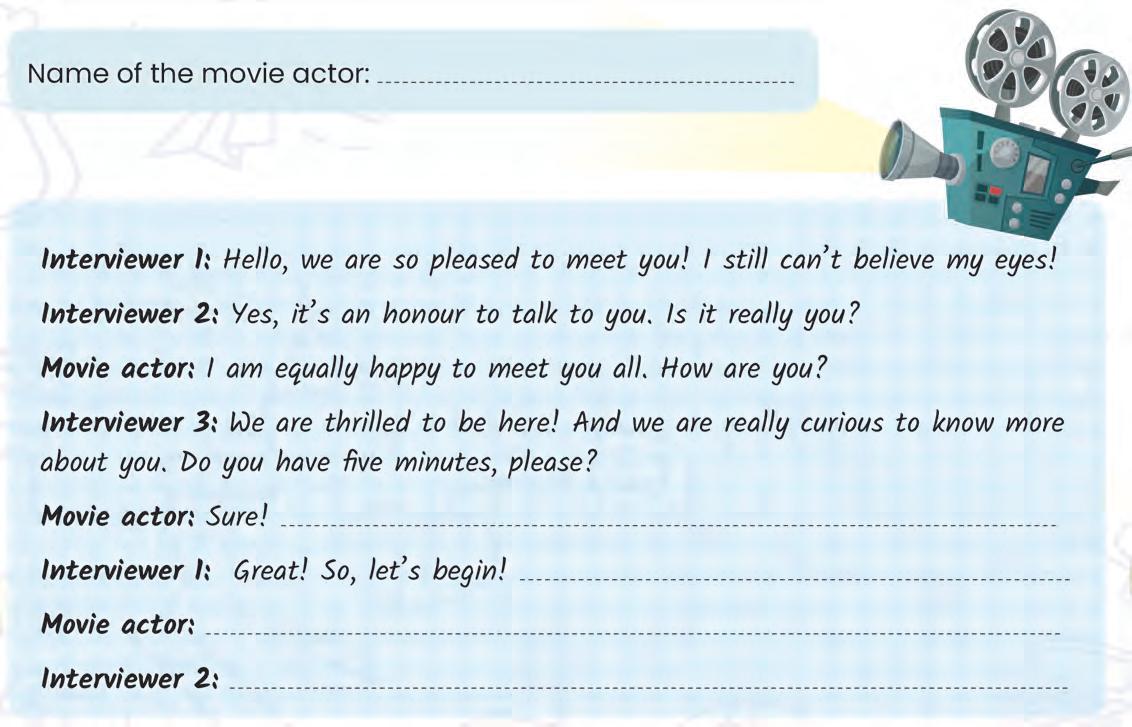
• Presentation and Feedback 30 min
• Invite ALL groups for the presentation. Select randomly through games. (pagevii)

• Instruct: Step forward in groups, and enact your interviews. Play your parts with appropriate expression and body language.
• Sample:
Ranjan Kumar
You get to ask just 3 questions.
What is one role you wish to play?
I wish to play in Gabbar in Sholay! What do you do in your free time?
Part B - Period
2
8
What is your favourite food? I love eating Noodles as well as Dosai. spending time with us. we are glad to meet you. meet you all.
• Appreciate all presentations. Give concrete feedback on content, fluency, presentation style and team work.


“Thank you, team! Your interview was so thrilling. I loved the questions and answers you created. And you all acted so well!
I have one feedback: Look at the person you are interviewing while asking the question.
I like to read and listen to music. Sure! Let’s huddle. 9 Chapter 2 • Ask and Answer
Chapter 3 Can You Convince?
About the Chapter: Through this module, learners will develop the skill of persuasive speaking.

Listening Speaking Competencies: Learners will be able to
• Listen to and interpret key details in informational texts.
• Speak persuasively about the advantages or disadvantages of something.
Part A - Period 1
The Latest in Smartphones
• Read the text aloud OR play the Talking Book in the classroom.
10 min
• Ask questions as follows. Invite responses from as many learners as possible.
Before story: What is one gadget that you would like to have? Why?
During Story: After ‘many types of smartphones available in the shops and online, they all have the same basic features.’: What features of smartphones do you know about?
After story: What one feature of smartphones do you think is the most important? What is one caution you need to keep in mind when using a smartphone?

Speak on the Spot!
To Have or Not to Have?
• Divide the class into pairs.
• Instruct:
20 min
A. One of you speaks in favour of smartphones, while the other speaks against them. Write your names in the blanks accordingly.
B. Read the conversation prompts and practise your conversation.
• Allot 2–3 minutes to discuss and practise.
• Say: Now I will call some of the pairs to present their conversations. Take note of the following things:
A. First, tell us which partner is speaking in favour and which one is speaking against the use of smartphones.
B. Speak in complete sentences as you present your conversation.
C. Speak in the same sequence as given for the conversation.
• Invite AS MANY pairs to present as possible. Select randomly through games. (pagevii)

10
Sample:
they help us connect to the people we love and need.
We spend too much time watching and creating videos. This can waste our study time. Many smartphone applications help with our homework and learning new things.
The use of many applications needs the internet and cost us.
Good work! Your conversation was very informative! I liked that you shared new pros and cons. I have one feedback –Don’t forget to use expression while talking or presenting. If you struggle to find a word in English, you can ask for help.
Homework 1: E-Speak
Instruct the learners to complete both projects in the E-Speak section.

Project 5: Sell That Smartphone
This project will be evaluated automatically. Scan the QR code to see the submissions of your learners.
•
11 Chapter 3 • Can You Convince?
Project 6: Pros and Cons
This project will be evaluated by you. Scan the QR code to see the submissions of your learners.
Homework 2: Preparation for Part B
Explain steps 1–4 in the Plan and Speak section for prep work. Facilitate as follows.
1. Divide the class into pairs.
2. Instruct the pairs to pick any one pair of items from the given list of topics.


3. Instruct learners to discuss in pairs and fill in the notes for both the products. Suggest that they look at the hints and write about their advantages and disadvantages, following the format.
4. Post writing, suggest that they take one part (product) each and practise speaking in favour of their product. Together, they should practise it as a debate.
Part B - Period 2

Gadget Gurus

• Instruct learners to label the sentences according to their thinking.
• Invite a few learners to share their responses and reasons for it.
Plan and Speak East or West, My Product is the Best!
5 min
• Warm Up 5 min
A. Recapitulate the activity for the learners.
B. Instruct: Revise your notes. Practise how you will present the debate.
• Presentation and Feedback 30 min
• Invite ALL the pairs for presentation. Select randomly through games. (page vii)
12
Laptop vs Desktop
Laptop
Laptops it is easy to carry them. They are light in weight. We can use them for watching movies and reading articles. a
desktop
it is heavy and stays in one place. I support laptops.
Desktop
Desktops they can have a wide screen. We can adjust the height of the screen as well. So, they help us maintain good posture. a
laptop

they come in small screen sizes. you should buy only a desktop.
• Appreciate all presentations. Give concrete feedback on content, fluency, presentation style and teamwork.

Thank you! You were right about the benefits of your products. I loved how strongly you debated them! Next time, you should make sure that you put your strong points with more confidence.
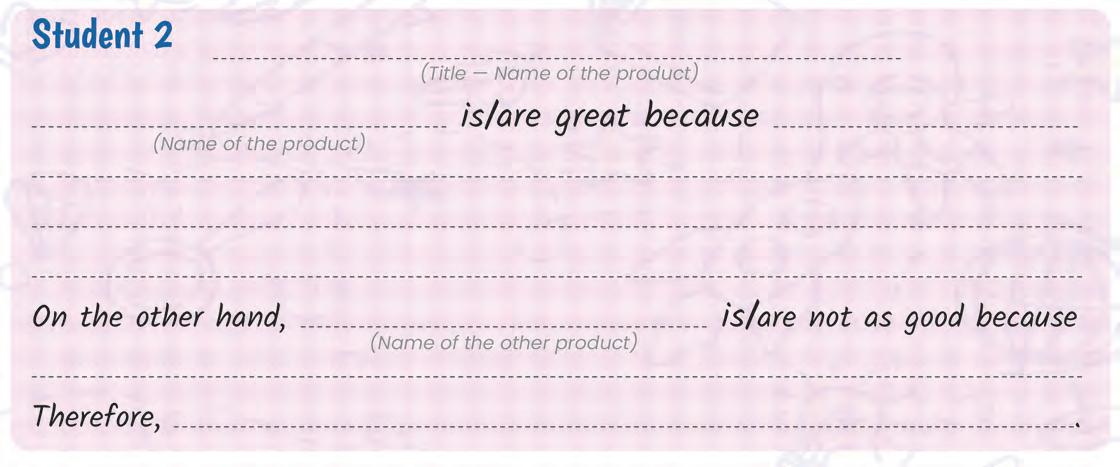
• Sample: 13 Chapter 3 • Can You Convince?
About this book
This “Conversations” book follows a unique spiraling approach that systematically builds language skills and enables children to express themselves verbally in real-world situations, thus preparing them for the needs of the 21st century world. Each chapter focuses on building specific and age-appropriate English language competencies and weaves together activities that are contextual, experiential, joyful and research-based.
Special features of this book:
• Activities based Learning: joyful and experiential activities that build English communication competencies.

• Texts as per NEP 2020 themes: exciting and stimulating texts that pave the way for English communication activities.
• Tech Integration: the book works in sync with the digital world, where various other activities and projects are undertaken. Learner outputs are evaluated through an AI-based speech recognition engine.
• Assessment of Speaking & Listening as per CEFR: the program includes special assessments that allow systematic reporting of skill growth as per the CEFR.
• Teachers’ Manual: the book is complemented by the Teachers’ Manual that enables teachers to conduct each session effectively.
About Uolo
Uolo partners with K12 schools to provide technology-based learning programs. We believe pedagogy and technology must come together to deliver scalable learning experiences that generate measurable outcomes. Uolo is trusted by over 8,000 schools with more than 3 million learners across India, South East Asia, and the Middle East.

Copyright © 2023 all rights reserved.
hello@uolo.com
Singapore | Gurugram | Bengaluru

































